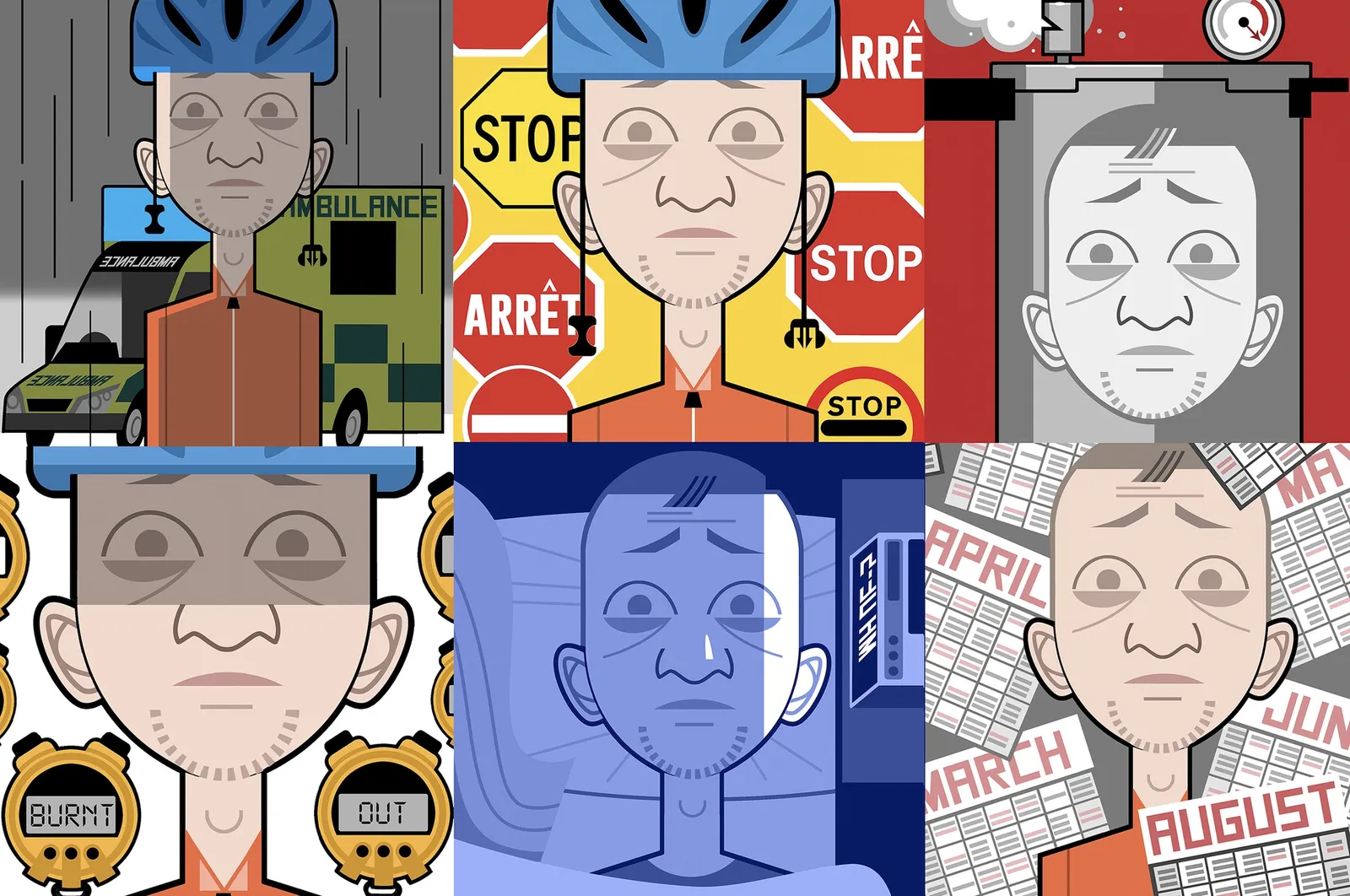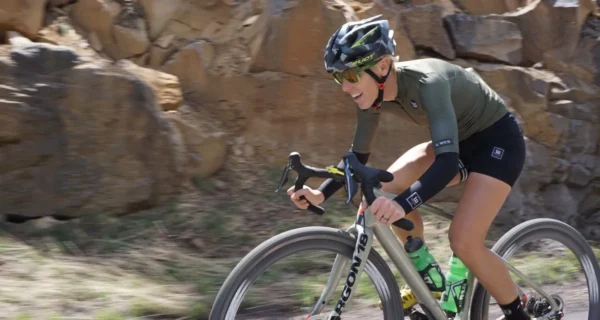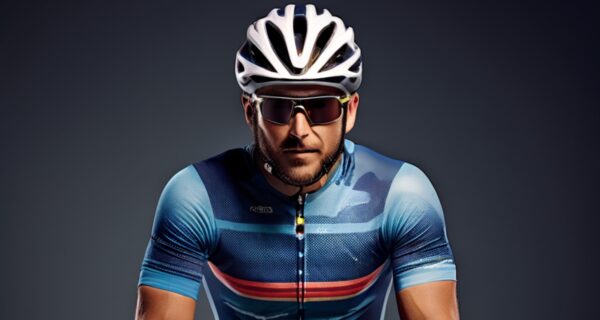Cycling lights a fire in riders, but too much pressure can burn that passion away.
A psychologist who experienced burnout firsthand shares how to stay on the right side of the flames.
Two days after Christmas 2022, I woke up covered in bandages.
The day before, a mechanical issue during a training ride sent me over my handlebars at 52 kilometers per hour.
I spent only five minutes in the emergency room before deciding to manage my injuries at home.
What hurt most was that I had just started a training break after three months of intense buildup to the Australian National Championships elite road race, only two weeks away.
Four days later on New Year’s Eve, I stood in my bathroom with the tumble dryer on and no fan running.
In the middle of Australian summer, I completed my heat training as sweat dripped through my bandages onto the blood-soaked floor.
I made it to my target race but immediately after began experiencing anxiety, lack of energy, detachment and irritation.
It didn’t feel like a temporary low; it felt like I was done with cycling.
I’ve kept riding since then, but looking back, what I experienced was burnout.
Context matters here: I was 37 at the time, a decent-level amateur cyclist, and working full-time as a clinical psychologist.
This experience shaped my interest in burnout in elite sport, particularly in cycling.
Most people understand burnout, but the term gets used too casually.
Burnout isn’t just tired legs or a bad training block.
In sports psychology, it involves three linked dimensions: persistent emotional or physical exhaustion, reduced feeling of accomplishment where efforts seem to count for nothing, and creeping detachment from the sport you once loved.
In cycling, burnout shows up as declining performance, joyless racing, loss of motivation, poor sleep, flat mood, irritability, and wanting to stop altogether.
Stepping away from cycling doesn’t always mean burnout though.
Some riders walk away for safety, lifestyle or identity reasons.
The line between choice and collapse isn’t always clear.
Cycling’s Growing Crisis
After the 2025 Tour de France, Tadej Pogačar suggested he might retire after the 2028 Olympics, before his 30th birthday.
Australian sprinter Caleb Ewan stepped away at the start of this season despite a new contract with Ineos Grenadiers.
More recently, Louis Kitzki, a 21-year-old Alpecin-Deceuninck development rider, retired after witnessing two fatal crashes.
Before them, Tom Dumoulin, Marcel Kittel and Taylor Phinney all left the sport in their prime, citing mental and physical exhaustion.
Cycling has always been brutally demanding, but this recent wave of early exits points to something deeper.
The decision to quit may confuse those who envy the pro lifestyle—being paid to train and race, with sponsors, structure, and fan adulation.
Yet those ingredients create risk, and success becomes a burden when it feels like an obligation.
The modern racing style doesn’t help: flat-out from the flag drop, with constant attacks, endless media duties and tightly packed calendars.
I spoke to a development rider named James (not his real name) who moved to France chasing the dream of turning pro.
He quickly realized the lifestyle “cracked” him—there was no room for anything else beyond cycling.
The bike, once an escape, became a trap. Eventually he couldn’t “escape the escape.”
Like Kitzki, James was disturbed by the risks.
Races halted only when no more ambulances were available in a culture where events seemed to matter more than riders’ lives.
James eventually stepped away and rebuilt his love of cycling recreationally.
Returning home, he noticed immediate improvements in physical performance: “In terms of my head directing my legs, there was loads of change.”
For James, professional cycling was a toxic working environment.
Short contracts, limited agency and little say over conditions often leave riders vulnerable.
Young athletes, often barely out of school, are thrust into high-pressure environments abroad with language barriers, relentless competition and minimal psychological support.
When being a rider becomes the primary identity, setbacks aren’t just disappointments—they become existential threats.
Understanding the Why
Self-Determination Theory, a model in motivation psychology, identifies three key needs for sustained effort: autonomy (having choice), competence (a sense of mastery), and relatedness (belonging and connection).
When these are absent, burnout risk rises.
Teams need to grow not just talent but trust, maturity and meaning for their riders.
Riders offered the greatest foundation for self-determination are better able and more willing to continue in the sport.
Ex-pro Yanto Barker explained that when he started cycling, he was racing his way out of poverty.
The pressure of the sport was less than the pressure of his early life.
Racing gave him purpose: “I loved racing, I loved who it made me.”
To avoid burnout, Yanto viewed motivation as a luxury, focused on the present and learned from others.
He described how burnout often results from “not being in the moment, and catastrophizing about the future.”
Since retiring in 2016, Barker has reflected on cycling as a space to think and a vehicle for problem-solving in his work as CEO of clothing company Le Col.
Jack Rootkin-Gray, in his second year at EF, draws a distinction between being burnt out and simply being unhappy with circumstances.
“When I’ve felt burnt out, it’s different to when I’ve felt unsatisfied,” he said.
His advice to others is to “imagine you were the most motivated you could be, how much energy you would have and how much you would enjoy your job.”
He finds small changes; turning the power meter off, trying new tech or switching routines—can help keep burnout at bay.
Amateurs Face It Too
Burnout isn’t limited to professionals.
Many cases occur in the amateur ranks, though they receive little attention.
Sometimes amateur riders push themselves harder than pros: 20-plus-hour weeks on top of full-time jobs, chasing race results that only immediate rivals notice.
For some it’s meaningful, but for others it becomes a grind.
Stepping back can feel like failure when your identity over many years becomes wrapped up in being the ‘fit one’ or the ‘first-cat racer.’
Social media magnifies this pressure.
Toby Langstone, 32, a teammate of mine on the Le Col race team, described it as a slippery slope.
“Before you know it, you’re going on a Saturday ride with people who are sleeping in oxygen tents and running TT tires on your road bike during winter.”
Josh Kent, 30, another teammate, told me he feels the need to ride 12 to 15 hours per week just to be adequately fit to compete.
For many, this creep erodes the joy, freedom and spontaneity that drew them to the bike initially.
Tim Strickland, 30, who rides for GFTL, spoke about how acceptance and finding meaning are key to sustainability: “You’ve got to find your level and be happy with what that brings.”
Writing this at the end of the amateur season, I was struck by how many people felt they were experiencing burnout.
The Path Forward
Burnout in cycling is real and apparently rising, but it isn’t inevitable.
The pressures for amateur racers aren’t so different from those affecting pros.
By listening to riders, supporting them as people and fostering meaning at every level, we can build a culture where cycling becomes a place where people find their own way to keep passion alive.
For me, that lesson began on a bathroom floor in Australia, bandaged and broken.
What I’ve learned from pros, development riders and amateurs is that connection, identity and joy matter as much as fitness or form.
The goal isn’t to deny or ignore struggle—it’s to stay connected to one another in a compassionate, joyful way.
How to Bounce Back
Burnout often starts subtly: declining performance despite training, joyless racing, loss of motivation, poor sleep, flat mood and irritability.
Understanding burnout requires considering multiple aspects of a rider’s experience.
In the therapy room, I explore four questions: When did you start feeling like this?
- What are you really chasing?
- Who are you if you aren’t cycling?
- When will you know that you’ve done enough?
Treatment involves physical rest and recovery, but also reconnecting to meaning.
Philosopher Nietzsche wrote: “He who has a why can bear almost any how.”
Sometimes the solution isn’t to stop riding but to ride differently.
Let go of the numbers, try new tech, use cycling for problem-solving, or seek connection over competition.
Burn Bright, Don’t Fade
If burnout is becoming more common, it’s not because riders are weaker.
It’s because the demands have changed—and because we’re finally talking about it.
For teams: provide mental health support as standard, create proactive cultures where honesty is rewarded, and celebrate resilience and growth as well as results.
For coaches: recognize signs of demotivation early, avoid over-glorifying sacrifice, build rest into plans, and focus on autonomy and purpose.
For riders: stay connected, know your why or be willing to find a new one, don’t wait until you feel broken to ask for help, try new ways to reframe cycling, and remember that stepping back doesn’t mean giving up.
The real challenge and the real victory is learning how to climb out of the hole and fall back in love with the bike again.







